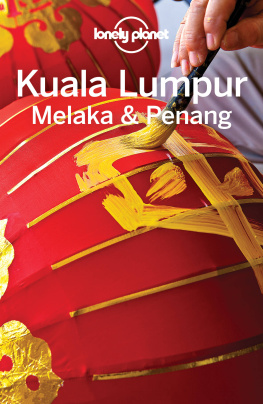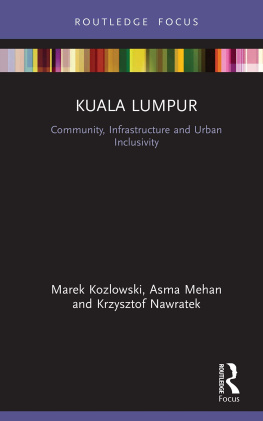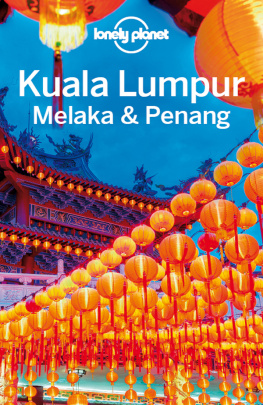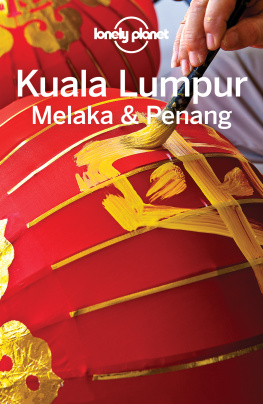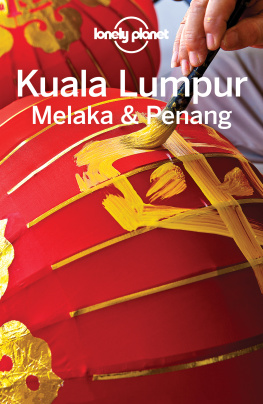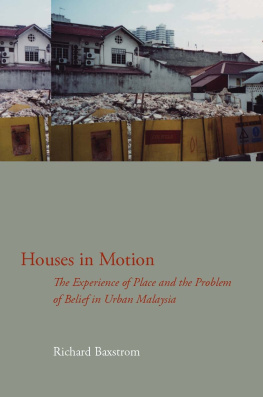Kuala Lumpur at War
1939-1945
A History of Kuala Lumpur and Selangor
During World War Two
Andrew Barber

KARAMOJA
Kuala Lumpur Malaysia
BY THE SAME AUTHOR
Malaysian Moments
Malaya the Making of a Nation 1510-1957
Penang under the East India Company 1786-1858
Penang at War 1914-1945
First published in Malaysia in 2012
Copyright by Andrew Barber
Maps by Lileng Wong
The moral right of the author has been asserted.
No part of this book may be used or reproduced in any manner whatsoever without written permission from the author except in the case of brief quotations embodied in articles, reviews or publications.
Every reasonable effort has been made to trace copyright holders of material used or cited in this book, but if any have been inadvertently overlooked, the publisher would be pleased to hear from them.
Karamoja Press - AB&A Sdn Bhd
Suite A-6-3 Plaza Mont Kiara
50480 Kuala Lumpur, Malaysia
Design by Lileng Wong
Printed by United YL Printers Sdn Bhd
To Dick and Gill Hart

Acknowledgments
I would like to thank the staff of Arkib Negara in Kuala Lumpur, the British Public Records Office at Kew, the Imperial War Museum in London and the National Archives of Australia for their help and advice. Michael Thompson, Anthony Cooper, Jonathan Moffatt, A. Gunanathan, Michael Pether, John Nicholson, Andrew Hwang, Mark Disney, Datuk Bertie Talalla, Ronnie McCrum, Mason Nelson, Paget Natten, Tun Dr. Siti Hasmah, John Nicholson, Ellen Shustik, Elizabeth Cardosa, Dato Arrifin Yacob, Charlie Chelliah, Dato Henry Barlow, Merlene Narcis, Dr. Loporte Khoo, Roger McGowan and Dr Tim Harper were all very supportive. Mark Wheeler and Anwar Yusoff at ConocoPhillips have generously continued their support of my work and the Lighthouse Childrens Home by sponsoring copies of the book. Working as a guest lecturer on Cunards Queen Elizabeth gave me the time and peace in which to make great strides with the writing, and my thanks go to Tim Wilkin and Keith Maynard. The Committee of the Oxford and Cambridge Society of Malaysia have kindly offered to host the books launch. Puan Sri Elizabeth Moggie critiqued the text with wonderful focus and attention and acted as an intellectual conscience, delving into the sourcing detail and not letting go until she was satisfied! Her help was enormous and I am indebted to her for the time and effort she devoted to the project. Lileng Wong, having survived four earlier books, once again proved a great partner in crime, undertaking all the design work, maps and printing responsibilities. Vithya Muthusamy proved an engaging, fun and somewhat quirky research assistant. Caroline, my wife, was as ever a willing and demanding sub-editor, who waded through more versions of the book than she cares to remember. It was in many ways a team effort but any errors, either of fact, omission or interpretation are, of course, my own.
Illustrations and Images
The front cover is adapted from an image in the war-time magazine Fajar Asia courtesy of Arkib Negara. The 1935 Kuala Lumpur town map is courtesy of John Nicholson. The remaining photographs and images are from Arkib Negara or the authors collection. The maps were compiled by Yong Aun.
Introduction
This book is about the experience of war on Kuala Lumpur. It is not a military history, in the sense that there was very little fighting, either when the Japanese entered the city in January 1942 or when the British returned in September 1945. Rather, the focus of the book is on how conflict, the Japanese occupation and the return of the British impacted on the city and its people. The three years and eight months of Japanese governance wrought huge change and were a tilting point in the history of Malaya. As the capital city, Kuala Lumpur was a central player in these changes. This is the story of those years.
The war impacted on individuals and communities in very different ways and there was no single or uniform narrative. Rather, the war years present a hybrid of varied, complex and often contradictory experiences. For example, while one fleeing British family might make it to Singapore and safety on a departing boat, others might spend the war in an internment camp, or worse, embark on a vessel sunk by the Japanese in the sea-lanes outside Singapore. Similarly, a local girl might find herself in the wrong place at the wrong time as the Japanese rounded up victims for their comfort houses, while others would survive the war unmolested and unharmed. In general, the Japanese occupation of Kuala Lumpur is remembered for its brutality but some local residents formed close and friendly relationships with Japanese civilians stationed in the city and recall their politeness and exquisite manners. If nothing else, war is capricious.
It is, however, possible to use some big strokes, particularly when assessing the impact of the war on individual communities. We can, for example, say that the Chinese - Japans historic enemy - were targeted for notably brutal and systematic repression at the hands of the dreaded military security police, the Kempetei . The Indian community, though not seen as the enemy by the Japanese, was treated with malign expediency, and many thousands of its young men were dispatched to work, and to die, on Japans death railways. Kuala Lumpurs Malay community suffered the least, but the war was nonetheless a period of strain, poverty and disorientation. War also brought experiences that were common to all. Particularly in the latter years of the war, shortages and famine were commonplace for all communities. These were the tapioca years when hunger and starvation were prevalent.
In researching this book I have been struck by a general lack of interest in the war by Malaysians, particularly of the younger generation. Unlike in Europe and the United States, which have perhaps been overly occupied by these years, most Malaysians seem disconnected and disinterested. One explanation could be that it was perceived not to be our war, and that Malaya was seen simply as a battleground for power hungry empires. There is some truth in this, and certainly Malayans were the innocent victims of events and forces emanating from well beyond their shores, but to blank out the lessons and consequences of the war is, surely, a step too far. For one, many Malaysians lost family during the conflict and they deserve better recognition and commemoration.
There have been plenty of books about the Malaya campaign, the fall of Singapore and some about the impact of the Japanese occupation but not, I believe, one specifically about the war in Kuala Lumpur and the surrounding state of Selangor. I hope this helps fill that gap. There will, I am sure, be many errors of fact and interpretation, for which I take full responsibility. But it has been fun researching and writing this book, and I hope others enjoy reading it.
Chapter One
War Clouds West and East
In late August 1939, German forces were massing on the border with Poland. Just twenty-one years after the end of the Great War, the war to end all wars, Europe was again on the brink of another all-consuming conflict. That month, Imperial Airways announced that practically all the available accommodation on the routes outbound from England has been sold for some months ahead but noted that it was still possible to book flights to Britain. At this stage, Asia looked to be a sanctuary from the impending war in Europe, and assurances from the Japanese that they would remain neutral in any conflict helped buttress this sense of detachment. Travellers were flowing from Europe to the supposed safety and security of the East.
Next page

